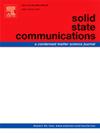Improving the enormous coercivity in Ba0.54Ca0.46Fe6.5Al5.5O19 M-type hexaferrite via annealing treatment, prepared by sol-gel auto-combustion method
IF 2.1
4区 物理与天体物理
Q3 PHYSICS, CONDENSED MATTER
引用次数: 0
Abstract
Improved rare-earth-free M-type hexaferrite powders with the formula were synthesized via the sol-gel auto-combustion method. The samples were annealed between 1100 °C and 1250 °C with a 50 °C step. The effects of annealing treatment on the structural, microstructural and magnetic properties were studied. X-ray diffraction analysis show as major phase with impurity for the calcination temperatures below 1250 °C and single phase at 1250 °C. The average crystal size increases (50.23–74.14 nm) with the increase in the annealing temperature. The surface morphology was examined using field emission scanning electron microscopy, an average grain size was found to increase from 0.58 to 0.97 μm. powders showed an enormous coercivity () that increased from a value of 21.16 kOe to 24.18 kOe with increasing annealing temperature from 1100 °C to 1250 °C. Various magnetic parameters were estimated including the anisotropy field () and the effective magnetic anisotropy constant () which permitted us to understand the effect of annealing treatment on the values of . The obtained values in powders demonstrate a significant potential for the high-density recording applications, thereby presenting a cost-effective alternative to expensive rare-earth materials.
采用溶胶-凝胶自燃烧法制备Ba0.54Ca0.46Fe6.5Al5.5O19 m型六铁素体,通过退火处理提高了其巨大矫顽力
采用溶胶-凝胶自燃烧法合成了配方为Ba0.54Ca0.46Fe6.5Al5.5O19的改进型无稀土m型六铁体粉末。样品在1100°C至1250°C之间进行50°C步长退火。研究了退火处理对合金组织、显微组织和磁性能的影响。x射线衍射分析表明,在1250℃以下煅烧时,含杂质的主要相为Ba0.54Ca0.46Fe6.5Al5.5O19,在1250℃煅烧时为单相。随着退火温度的升高,平均晶粒尺寸增大(50.23 ~ 74.14 nm)。采用场发射扫描电镜观察其表面形貌,平均晶粒尺寸由0.58 μm增大到0.97 μm。Ba0.54Ca0.46Fe6.5Al5.5O19粉末的矫顽力(Hc)随着退火温度从1100℃升高到1250℃,从21.16 kOe升高到24.18 kOe。计算了各向异性磁场(Ha)和有效磁各向异性常数(Keff)等磁性参数,从而了解了退火处理对Hc值的影响。在Ba0.54Ca0.46Fe6.5Al5.5O19粉末中获得的Hc值显示出高密度记录应用的巨大潜力,从而为昂贵的稀土材料提供了一种具有成本效益的替代品。
本文章由计算机程序翻译,如有差异,请以英文原文为准。
求助全文
约1分钟内获得全文
求助全文
来源期刊

Solid State Communications
物理-物理:凝聚态物理
CiteScore
3.40
自引率
4.80%
发文量
287
审稿时长
51 days
期刊介绍:
Solid State Communications is an international medium for the publication of short communications and original research articles on significant developments in condensed matter science, giving scientists immediate access to important, recently completed work. The journal publishes original experimental and theoretical research on the physical and chemical properties of solids and other condensed systems and also on their preparation. The submission of manuscripts reporting research on the basic physics of materials science and devices, as well as of state-of-the-art microstructures and nanostructures, is encouraged.
A coherent quantitative treatment emphasizing new physics is expected rather than a simple accumulation of experimental data. Consistent with these aims, the short communications should be kept concise and short, usually not longer than six printed pages. The number of figures and tables should also be kept to a minimum. Solid State Communications now also welcomes original research articles without length restrictions.
The Fast-Track section of Solid State Communications is the venue for very rapid publication of short communications on significant developments in condensed matter science. The goal is to offer the broad condensed matter community quick and immediate access to publish recently completed papers in research areas that are rapidly evolving and in which there are developments with great potential impact.
 求助内容:
求助内容: 应助结果提醒方式:
应助结果提醒方式:


